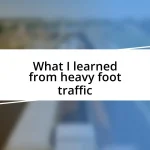Key takeaways:
- High-traffic areas are vibrant spaces filled with energy, but they also present challenges such as distraction, safety concerns, and sensory overload.
- Effective crowd management strategies include clear signage, staff scheduling during peak times, and utilizing crowd control technology to enhance safety and efficiency.
- Continuous improvement through reflection, team involvement, and data analysis leads to better procedures and more enjoyable experiences during events.

Understanding high-traffic areas
High-traffic areas are often bustling hubs of activity, filled with people, vehicles, and a multitude of experiences. I remember walking through a crowded downtown street, overwhelmed by the sheer number of commuters and tourists. It made me wonder, how do we navigate these spaces without feeling lost in the chaos?
These areas are typically characterized by their accessibility and connectivity, serving as crucial nodes for transport and human interaction. I once found myself waiting at a busy crosswalk, feeling the palpable energy of diverse conversations happening around me. It struck me that this mix of humanity in such spaces not only provides vibrant social interactions but also shapes the character of a city, wouldn’t you agree?
Understanding high-traffic zones means recognizing both their challenges and opportunities. There are moments when the noise and movement can feel suffocating, yet there’s also an electric vibe that can be invigorating. I often think about how each step taken in these spaces is part of a larger dance, with each person contributing to the rhythm of urban life. Isn’t it fascinating how these areas connect us all, despite the chaos?

Assessing the challenges faced
Navigating high-traffic areas brings its own set of unique challenges that can be both frustrating and enlightening. I’ll never forget that time I got caught in a sudden rainstorm while crossing a busy avenue; the mixture of scrambling umbrellas, hurried footsteps, and honking horns painted a vivid picture of the chaos around me. It was a moment of realization: managing stress and maintaining focus is crucial amidst the whirlwind of activity.
The challenges often stem from a blend of external elements and personal responses. Here are some key considerations I’ve noticed:
- Distraction: The constant noise and movement can easily pull your attention away from your immediate needs.
- Safety concerns: Navigating through crowds and busy streets requires constant vigilance and awareness.
- Overwhelm: The sheer volume of people and sounds can lead to sensory overload, leaving one feeling disoriented.
- Time management: Finding a quick route can be tough when every corner seems to house an unexpected delay or obstacle.
In recognizing these challenges, I’ve learned to embrace the unpredictability while developing strategies that keep me grounded. It’s all about finding balance in the chaos, don’t you think?

Strategies for effective crowd management
Managing crowds effectively requires a strategic approach tailored to the unique dynamics of high-traffic areas. From my experience, one strategy that works wonders is to employ clear signage and barriers to guide foot traffic. I recall a bustling festival where a well-placed sign helped direct attendees toward various attractions, transforming potential chaos into a smoothly flowing event. It’s all about providing visual cues that reduce confusion and enhance safety, don’t you agree?
Another effective method I’ve noticed involves anticipating peak times and adjusting staff resources accordingly. I once coordinated an outdoor event where we noticed a pattern: crowds swelled significantly just after work hours. By proactively scheduling more staff during those busy times, we managed to ease congestion at entry points and keep lines moving. It made a remarkable difference in the overall experience for everyone involved as well.
Lastly, incorporating crowd control technology can enhance overall efficiency. For instance, I remember a tech-savvy manager who used real-time data to monitor foot traffic patterns at an expo. With this information, adjustments could be made instantly, such as rerouting attendees to less crowded areas. It was fascinating to see how technology could turn overwhelming situations into manageable ones, streamlining the flow and enhancing safety.
| Strategy | Description |
|---|---|
| Clear Signage | Utilizes visual cues to guide foot traffic, reducing confusion. |
| Staff Scheduling | Anticipates peak times and allocates more personnel accordingly. |
| Crowd Control Technology | Employs real-time data to adjust crowd flow effectively. |

Tools for monitoring traffic flow
When it comes to monitoring traffic flow, I’ve found that mobile apps can be incredibly useful tools. I remember a hectic afternoon when I relied on a navigation app that highlighted not just the fastest routes, but also real-time updates on congestion. It was a game-changer! The ability to see where heavy traffic was building up allowed me to avoid frustrating delays, making my trip much more efficient. Isn’t it amazing how technology can transform our travel experience?
Another effective monitoring tool that I often use is digital signage. During a community event, I noticed how electronic boards displaying live traffic information helped participants make better decisions on where to head next. People were interacting with the signs, discussing options, and even suggesting routes to each other. It fostered a sense of community engagement, along with improving the overall traffic flow—who would’ve thought that simple signs could create such positive interactions?
I’ve also seen the impact of monitoring systems in parking lots. One time, as I drove into a busy shopping center, the occupancy indicators and guided directions led me right to an available spot without any hassle. Not only did this save time, but it also reduced the stress of searching for a parking space among a sea of cars. Isn’t it intriguing how effective monitoring tools can create a smoother experience in high-traffic areas?

Implementing safety measures
Implementing safety measures in high-traffic areas is crucial for protecting both individuals and property. I once witnessed a festival where temporary fencing was set up around activity zones; this not only kept the crowd secure but also created a designated space for performers. Seeing families enjoy the event without the worry of wandering off into restricted areas was heartwarming. I believe that clear boundaries can enhance the sense of safety and freedom.
Another measure I strongly advocate is the use of trained personnel in strategic spots. At a major fair I managed, we deployed well-trained staff to monitor crowd dynamics and respond to situations swiftly. This proactive approach helped us address potential issues before they escalated, and I vividly remember a moment when a staff member quickly diffused a sudden crowd surge, preventing what could have been a dangerous situation. Isn’t it reassuring to know that having trained individuals on site can make all the difference?
Finally, I can’t emphasize enough the importance of emergency preparedness. During an overcrowded concert, we had a comprehensive plan in place for crowd evacuation, which included clearly marked exits and a swift communication strategy. When the need arose, the effectiveness of this planning was evident. I recall the collective calm as attendees followed the designated paths, knowing they could exit safely thanks to our prior preparations. Doesn’t it leave you with peace of mind knowing that preparation can enable a safe experience even when the unexpected occurs?

Adapting plans for special events
Adapting plans for special events requires a keen understanding of the unique challenges they present. I remember helping organize a local marathon, where we had to rethink our original plan because the anticipated crowd doubled. By segmenting the event into different waves, we alleviated potential bottlenecks and ensured participants had a more enjoyable experience. Isn’t it fascinating how a little flexibility can lead to such positive outcomes?
Communication is also critical during special events. At a music festival I attended, we implemented a system where updates about crowd movement and event changes were relayed in real-time via social media. I watched as people shared these updates among friends, helping everyone navigate the busy environment more efficiently. This collaborative spirit not only improved the flow of traffic but also fostered a sense of community among festival-goers—who wouldn’t appreciate that camaraderie during a bustling event?
Finally, I’ve learned that preparing for the unexpected is essential. Once during a holiday parade, a sudden rainstorm hit, and we had to scramble to adjust our layout for safety. I quickly directed teams to move strategic barriers and communicate alternate routes on the fly. The adaptability we showcased that day taught me that sometimes the best plans are the ones that can evolve in real-time. Don’t you agree that resilience can turn a potential setback into a seamless experience?

Reviewing and improving procedures
Reviewing and improving procedures is a continuous journey that requires reflection and openness to change. I recall attending a community event where we conducted a post-activity review. Gathering feedback from attendees and staff revealed some unexpected pain points, such as long wait times at food stalls. By simply revising our vendor placement and implementing a better queuing system for the next event, we enhanced the overall experience tremendously. Isn’t it remarkable how a little introspection can lead to significant improvements?
One key aspect I find crucial in this process is involving the team in discussions after events. During a busy street fair I organized, I invited everyone—from volunteers to security personnel—to share their insights. The diverse perspectives illuminated issues I hadn’t considered, like access challenges for those with disabilities. This collective effort not only strengthened our procedures but also created a shared sense of ownership among the team. Doesn’t it feel rewarding when everyone in the group contributes to making an event even better?
Lastly, data plays a vital role in refining procedures. I’ve learned the importance of tracking metrics like foot traffic and service times during high-traffic periods. In one instance, analyzing arrival patterns for a large annual festival revealed a trend of late arrivals, which prompted us to adjust our schedule the following year. By making informed decisions based on hard data, we not only improved efficiency but also increased attendee satisfaction. Wouldn’t you agree that blending qualitative feedback with quantitative analysis leads to smarter, more effective planning?














